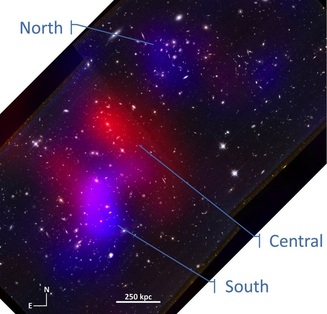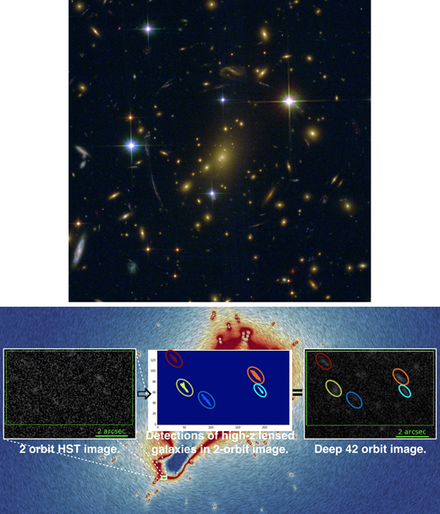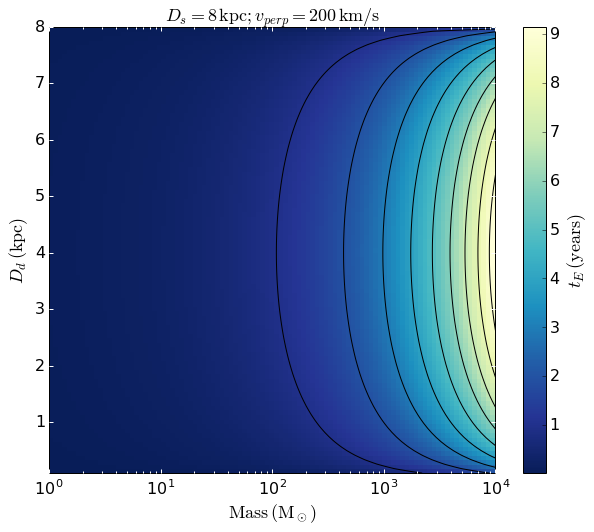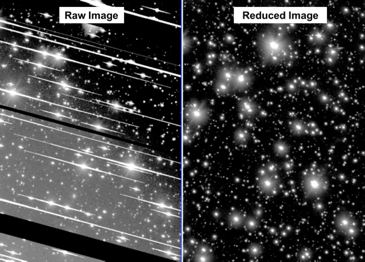Constraining Dark Matter with the Musket Ball Cluster
I have been leading the effort to study in detail a newly discovered dissociative galaxy cluster merger (DLSCL J0916.2+2951 a.k.a the Musket Ball Cluster), were the collisionless dark matter (blue, in the figure) and galaxies have become separated from the collisional cluster gas (red, in the figure). To date only ten dissociative mergers have been confirmed, the most famous being the Bullet Cluster. These dissections of the cosmos are proving to be some of the best laboratories for studying dark matter.
Read More For a more detailed account see our journal article "Discovery of a Dissociative Galaxy Cluster Merger with Large Physical Separation".
|
Research Interests
Collaborators
(Apologies for the incomplete list; fortunately this has grown more rapidly than I can keep up with.)
|
Studying the First Galaxies

I am part of the Reionization Lensing Cluster Survey (RELICS), a Hubble Space Telescope Treasury program to obtain the first HST infrared imaging of 41 massive galaxy clusters which magnify the high redshift universe and enable us to efficiently search for the first galaxies in the universe. We use a modified version of our faint satellite detection algorithm to enable detection of ultra-faint background galaxies that highly magnified and sheared through gravitational lensing by the massive foreground clusters. Our algorithms enable us to detect ultra-faint sources in two-orbit deep HST observations that with other methods were only detected in much deeper 42-orbit deep HST observations.
In the figure on the left, the background image shows the scalar magnification field (blue to red) and vector shear field (lines) for Frontier Fields cluster MACS J1149.5+2223 produced by our team (Johnson, Sharon+16), based on a lens model from bright multiply lensed background galaxies. Left: A 4''x8'' region from the 2-orbit HST-ACS F814W CLASH image in the high magnification/shear region of MACS J1149.5+2223; log scale. Middle: Segmentation image of detected sources after running our cluster lens model informed maximum likelihood detection method. The CLASH catalog shows only two detections in this region (yellow and orange, both zphot=3). We however, detect 3 additional sources with greater than 5 significance. Right: The same region and scale but from the 42-orbit HST-ACS F814W Frontier Fields survey. All of the maximum likelihood detected images from the 2-orbit image are verified in the much deeper 42-orbit image. Note that some sources within the green region are apparent but were not detected, such as the source to the upper-right of the orange source, however none of these show significant signs of shear (i.e.~they are consistent with the PSF), thus they did not have significant likelihood of being lensed background galaxies, which are the focus of our effort. Regardless, it might be possible to detect such faint PSF-like sources in the shallow CLASH survey images with our method if we had used more than one band for detection and a PSF-like model.
In the figure on the left, the background image shows the scalar magnification field (blue to red) and vector shear field (lines) for Frontier Fields cluster MACS J1149.5+2223 produced by our team (Johnson, Sharon+16), based on a lens model from bright multiply lensed background galaxies. Left: A 4''x8'' region from the 2-orbit HST-ACS F814W CLASH image in the high magnification/shear region of MACS J1149.5+2223; log scale. Middle: Segmentation image of detected sources after running our cluster lens model informed maximum likelihood detection method. The CLASH catalog shows only two detections in this region (yellow and orange, both zphot=3). We however, detect 3 additional sources with greater than 5 significance. Right: The same region and scale but from the 42-orbit HST-ACS F814W Frontier Fields survey. All of the maximum likelihood detected images from the 2-orbit image are verified in the much deeper 42-orbit image. Note that some sources within the green region are apparent but were not detected, such as the source to the upper-right of the orange source, however none of these show significant signs of shear (i.e.~they are consistent with the PSF), thus they did not have significant likelihood of being lensed background galaxies, which are the focus of our effort. Regardless, it might be possible to detect such faint PSF-like sources in the shallow CLASH survey images with our method if we had used more than one band for detection and a PSF-like model.
MACHO 2
LLNL led a microlensing survey in the 1990’s to detect Massive Compact Halo Objects (MACHOs). The optical telescope observing campaign measured the changes in the flux of stars over time to find the distinctive orders-of-magnitude flux magnification of a massive object passing across the line-of-sight. We are now pursuing a similar survey that covers longer time baselines – and thus is sensitive to more massive objects – with modern wide-field imaging instruments.







